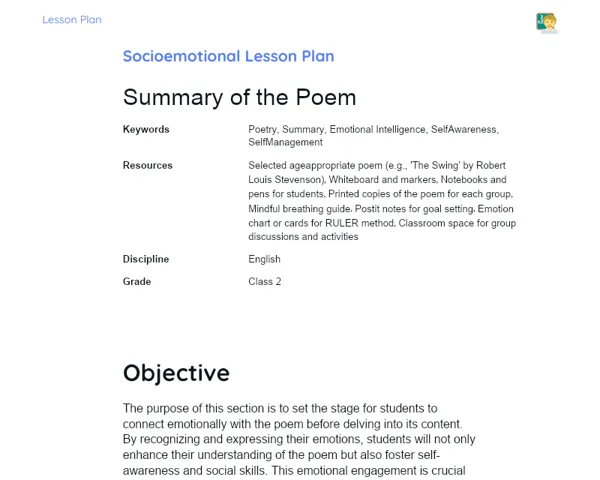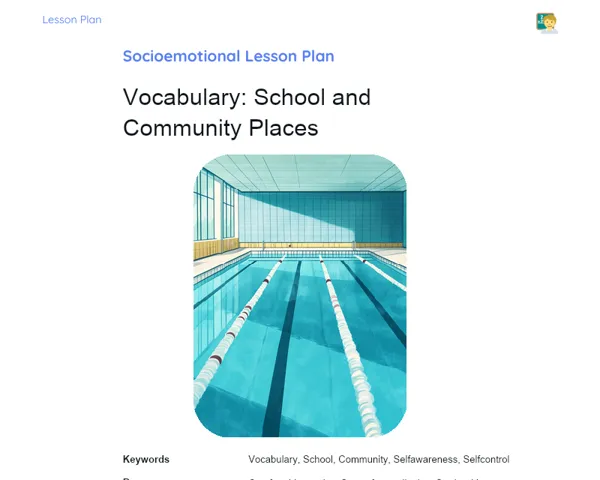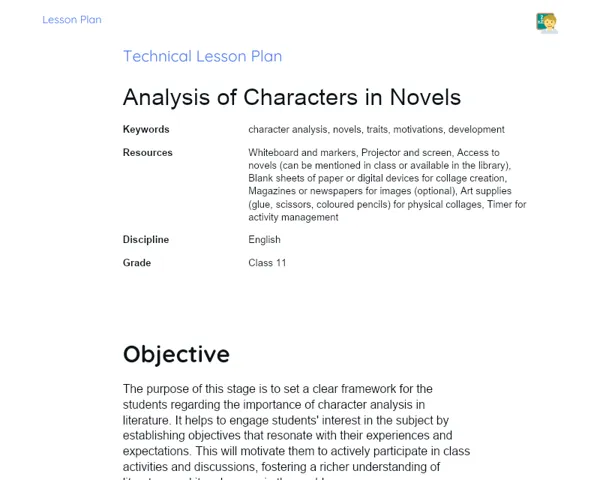Lesson Plan | Lesson Plan Tradisional | Verbs: Introduction to the Verb to Be
| Keywords | Verb to be, English, 3rd grade elementary school, Lecture, Affirmative and negative forms, Am, is, are, Simple sentences, Problem solving, Student engagement, Practical examples |
| Resources | Whiteboard or chalkboard, Markers or chalk, Copies of practical exercises, Projector (optional), Presentation slides (optional), Sheets of paper, Pencils or pens |
Objectives
Duration: (10 - 15 minutes)
The primary aim of this lesson plan step is to provide a clear overview of the key objectives that students should achieve by the conclusion of the lesson. This helps both the teacher and the students to understand the focus of the lesson, setting a strong foundation for the upcoming lecture.
Objectives Utama:
1. Understand the function and importance of the verb to be in the English language.
2. Learn to conjugate the verb to be in affirmative and negative forms.
3. Identify and correctly use am, is, and are in simple sentences.
Introduction
Duration: (10 - 15 minutes)
🎯 Purpose: The purpose of this section is to establish an initial context and ignite students' interest in the topic. By discussing the importance of the verb to be and sharing some interesting facts about its usage, students will feel more engaged and motivated to learn. This creates a firm foundation for the detailed explanations to follow, aiding in understanding and retention of the content.
Did you know?
🧐 Curiosity: Did you know that the verb to be features in some of the most famous lines in history? For instance, the phrase 'To be or not to be, that is the question' from Shakespeare's play Hamlet uses this verb. Additionally, this verb is among the first that children learn when they begin speaking English, just like we are doing in our class right now!
Contextualization
📚 Context: To kick off the lesson on the verb to be, it’s essential to highlight its significance in the English language. The verb to be is one of the most crucial and commonly used verbs in English. It lays the groundwork for forming basic sentences, describing states, identities, and characteristics. Without a solid grasp of the verb to be, communicating even simple and essential information in English becomes a challenge. Thus, mastering to be is a fundamental skill for every student aiming to learn English.
Concepts
Duration: (40 - 45 minutes)
📝 Purpose: The intent of this segment is to offer a thorough and structured discussion of the verb to be, including its forms and applications. By exploring the topics in a logical order, the teacher ensures students grasp each component before progressing. Including practical examples and guided exercises reinforces learning, allowing students to practice the verb to be in various contexts. This guarantees that, by lesson’s end, students can appropriately use to be in their sentences.
Relevant Topics
1. 🌟 Specific Topics:
2. What is the verb to be? Explain that the verb to be translates to 'to be' in English (similar to ser or estar in Hindi). It describes states of being, identities, and characteristics. For instance, 'I am a student' and 'She is happy'.
3. Forms of the verb to be Specify that the verb to be has three forms in the present: am, is, and are. Clarify that am is used with I, is with he, she, and it, and are with you, we, and they.
4. Usage in Affirmative and Negative Sentences Illustrate how the verb to be appears in affirmative and negative sentences. For example, 'She is a teacher' and 'She is not a teacher'. Teach that we can contract the negative form, changing is not to isn't.
5. Practical Examples Share several sample sentences utilizing the verb to be in its different forms. Examples might include, 'I am a boy', 'He is my friend', 'They are in the garden'.
6. Guided Problem Solving Suggest exercises for students to fill in the blanks with the correct form of the verb to be. For example, 'She ___ a doctor' (is), 'We ___ happy' (are), 'I ___ a student' (am).
To Reinforce Learning
1. Complete the sentence: 'He ___ a good person.'
2. Transform the sentence into the negative form: 'They are friends.'
3. Write an affirmative sentence using 'I am.'
Feedback
Duration: (15 - 20 minutes)
🎯 Purpose: The aim of this portion of the lesson plan is to recap and consolidate the learning about the verb to be. Through discussing answer responses, the teacher ensures students fully understand the material covered. Additionally, the engagement questions encourage critical thinking about using the verb to be, promoting meaningful application in different contexts.
Diskusi Concepts
1. 🔍 Discussion: 2. Complete the sentence: 'He ___ a good person.' 3. - Answer: 'He is a good person.' Note that 'is' is the right form of the verb to be when talking about 'he', 'she', or 'it'. 4. Transform the sentence into the negative form: 'They are friends.' 5. - Answer: 'They are not friends.' or 'They aren't friends.' Explain that to make it negative, add 'not' after the verb to be. The contraction 'aren't' can also be used. 6. Write an affirmative sentence using 'I am.' 7. - Answer: 'I am a student.' Note that 'am' is the form used with 'I'.
Engaging Students
1. 🤔 Student Engagement: 2. Why is the verb to be so significant in the English language? 3. - This question prompts students to contemplate the importance of to be across various contexts, observing its frequent usage. 4. How can you apply the verb to be to describe yourself and others? 5. - Encourage students to create sentences using 'I am', 'He is', 'She is', 'We are', and so forth. 6. What distinguishes affirmative and negative forms of the verb to be? 7. - This prompts a deeper understanding of the affirmative and negative forms while practicing sentence transformation. 8. Can you think of a well-known or popular sentence that incorporates the verb to be? 9. - Encourage students to connect their learning with sentences they know or have encountered, enhancing the relevance of the topic.
Conclusion
Duration: (10 - 15 minutes)
The goal of this section of the lesson plan is to review and reinforce the main concepts covered, ensuring students have a clear and comprehensive understanding of the content. Also, underscoring the practical applications and relevance of the topic accentuates the importance of learning, motivating students to utilize their knowledge in daily conversations.
Summary
['Understand the function and significance of the verb to be in the English language.', 'Learn to conjugate the verb to be in affirmative and negative forms.', 'Identify and use am, is, and are in simple sentences.', 'Know how to structure affirmative and negative sentences using to be.', 'Practical examples of using the verb to be in various contexts.']
Connection
The lesson bridged theoretical knowledge with practical application by thoroughly explaining the use of to be and subsequently providing practical examples and guided exercises. This allowed students to apply the theory in real-world contexts, solidifying their learning in a practical manner.
Theme Relevance
Understanding the verb to be is vital for students' day-to-day interactions, as it is broadly used to describe states, identities, and characteristics, both in everyday conversations and in written forms. Mastery of this verb enhances effective communication in English, enabling students to convey essential information clearly.



